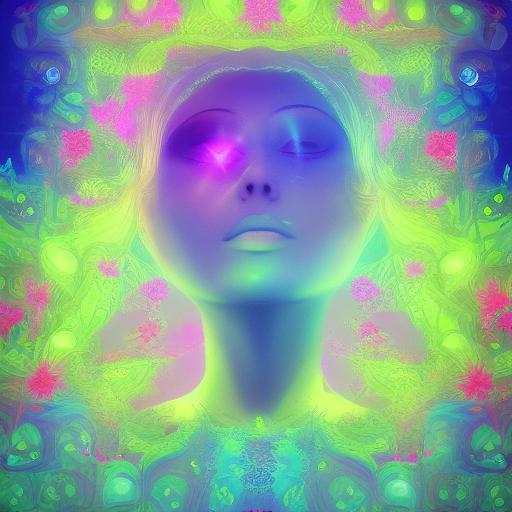How to write this prompt?
How each part influences the generated image:
- Psychedelic Art style: The AI model will be encouraged to create a colorful and surreal image, possibly with distorted or exaggerated shapes, patterns, and textures.
- Digital 2D medium: The image will be created in a flat and digital style, with clean lines, shapes, and colors.
- Woman floating among flowers in space subject: The AI model will create a female figure floating or levitating in a dreamy and cosmic environment, surrounded by flowers, planets, or stars.
- Aerial view camera angle: The image will be created from a top-down perspective, emphasizing the space and scale of the scene, as well as the floating and weightless quality of the subject.
- Blacklight lighting: The image will be created with a purple-blue tint, simulating the effect of a blacklight, which creates a neon and glowing effect on certain colors and materials.
- Shades of blue and green colors: The image will be created with a cool and soothing color palette, with blues and greens dominating the scene, creating a calming and harmonious ambiance.
To write a similar prompt, you can start by brainstorming the key elements of the image you want to generate, such as the style, medium, subject, camera angle, lighting, and colors. Then, you can provide a brief description of each element, focusing on the sensory and emotional aspects of the image. The more specific and vivid your descriptions are, the more likely the AI model will be able to generate a satisfying image. Finally, you can review and revise your prompt to ensure clarity, coherence, and creativity.
What is the difference between acrylic and oil paints in digital art?
In digital art, there is no difference between acrylic and oil paints, as they are just virtual brushes that simulate the look and texture of real-world paints. However, some digital painting software may offer different brush presets that mimic the characteristics of acrylic or oil paints, such as thickness, opacity, and blending.
How to create a 2D animation with a psychedelic art style?
To create a 2D animation with a psychedelic art style, you can use a combination of vibrant colors, bold shapes, and fluid movements. You can also experiment with distortion effects, such as warping, stretching, and morphing, to create a surreal and trippy vibe. You can use animation software such as Adobe Animate, Toon Boom, or Clip Studio Paint to create your animation.
Why is aerial photography useful in landscape design?
Aerial photography is useful in landscape design because it provides a bird’s-eye view of the site, which can reveal the topography, vegetation, and other features that may affect the design. Aerial photography can also help designers to visualize the scale and proportion of the landscape, as well as to identify potential obstacles or opportunities for design interventions. Additionally, aerial photography can be used to document the changes and evolution of the landscape over time.
Are there any copyright issues with using AI-generated art?
The answer to this question depends on the source of the data and algorithms used by the AI model to generate the art. If the data and algorithms are created by the artist or are in the public domain, then there should be no copyright issues. However, if the data and algorithms are copyrighted or patented by a third party, then using them to create art without permission could be considered copyright infringement. It is important to check the terms of use and licensing agreements for any AI software or data used in the creation of the art, and to obtain proper permissions or licenses if necessary.
Can I sell AI-generated art?
Yes, you can sell AI-generated art, but the ownership and copyright of the art may be a bit complicated. In general, the person who created the AI model and the one who trained it owns the copyright of the generated art. However, it is not clear how copyright law applies to AI-generated art, as it is a relatively new and evolving field. It is possible that courts may treat AI-generated art as a joint work between the human creator and the AI system, or may assign copyright to the human creator alone. Therefore, it is recommended to consult with a copyright lawyer to understand the legal implications of selling AI-generated art and to ensure that you have the proper rights and licenses to do so.
Visual Paradigm Online is a powerful design tool that enables users to seamlessly integrate AI-generated art into their graphic designs, resulting in visually stunning and engaging graphics with just a few clicks. With its user-friendly interface and an extensive collection of design templates and assets, Visual Paradigm Online offers a convenient and effortless way to experiment with various styles and layouts until you achieve the perfect combination for your project.


